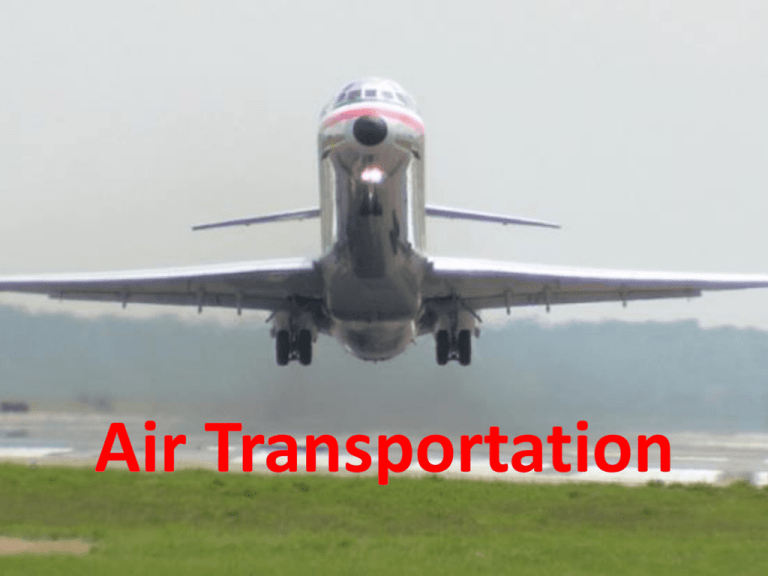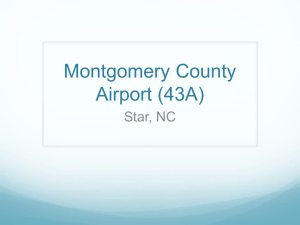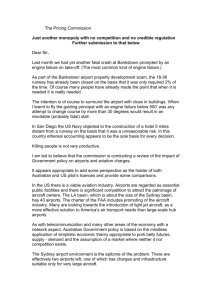Air Transportation
advertisement

Air Transportation Overview • • • • • By-product of the mail service Ideal for long distance and speed Relies on passenger revenue Speed and Competitive pricing led to growth Freight movement is limited. Ideal for highvalue goods, perishable goods, and emergency situations. History • 1903: Wright Brothers 1st powered/controlled flight. • 1905: 1st practical planes • 1908: US Post Office began air transportation development • WWI/Golden Era/WWII – Faster, Higher, Farther History • 1940s-50s: Jet engine/ airliners development. • 1960s-70s: Large airliners • 1978: Deregulation • 1980s-beyond: Energy, environmental issues • 9/11/2001: Security Blue Grass Airport History • 1920s-30s several small fields • WWII – Current Blue Grass Field • 1946: New Commercial Terminal. • 1968: 1st Jet Airliners • 2006: Runway Safety area improvement project Blue Grass Airport BGA Impacts • • • • 3,478 Jobs $104 million payroll $378 million output <1% within state, from state, to state (by weight), freight movement by tonnage Kentucky Air • Over 2.4 million passengers a year • 13.1 billion pounds of freight a year • 62 airports – 6 major ports (Louisville, Lexington, Paducah, Owensboro, Somerset, Hebron) – 3 major hubs (Delta, DHL, and UPS) • <1% within state, from state, to state (by weight), freight movement by tonnage UPS • Company founded August 28, 1907 in Seattle, Washington. • Began providing air service in 1929. • Fastest-growing airline in FAA history and is one of 10 largest airline in the US today • Main US Air Hub located in Louisville, KY. Began operation in 1982. Jet Aircraft Fleet: 226 Chartered Aircraft: 292 Airports Served: Domestic - 382 International - 323 Early Problems • • • • New developing technology. Reliability Safety Human factors Aircraft Types • General Aviation – Business, recreation • Commercial – Passenger, cargo • Military – Airlift, Combat Airliner Types • Narrow-body – 2-6 seats across – 1 aisle • Wide-body – 7-10 seats across – 1-2 aisles Propulsion • Internal combustion – In-line, radial • Turbojet • Turboprop • Turbofan – High and low bypass Legislative Acts • Air Commerce Act of 1926: 1st federal law, aided growth of industry • Civil Aeronautics Act of 1938: Creation of Civil Aeronautics Board (CAB), regulation of rates and routes • Federal Airport Act of 1946: Federal Aid Airport Program developed and improved airway facilities • Federal Aviation Act of 1958: Federal Aviation Administration (FAA) was created • Airport and Airway Development Act of 1970: Created the Airway Trust fund and established aviation taxes • Airline Deregulation Act of 1978: Ended regulation of rates and routes and abolished the CAB • The Airport and Airway Improvement Act of 1982: Passed to increase funding for airport construction and improvement • The Aviation Safety and Capacity Act of 1990: Established the passenger facility charge (PFC) • AIR-21:The Wendell Ford Aviation Investment Act for the 21st Century: Increased funding for highly congested large airports and to help smaller airports • The Aviation and Transportation Security Act of 2001: In response to September 11th, created the Transportation Security Administration (TSA) • Vision 100 Century of Aviation Act of 2003: Increased funding for improvements focused on environmental benefits Deregulation • 1978-1985: phased out of regulatory control • Increased competition • Easier for carriers to start up Civil Aeronautics Board • CAB • Operated from 1938-1985 • Regulated routes and fares for the airways and its carriers • Was abolished during deregulation Federal Aviation Administration (FAA) • Began operation December 31, 1958 • Replaced CAB • Department within US DOT • “Our mission is to provide the safest, most efficient aerospace system in the world. Learn more about how our mission is accomplished, the history of the FAA, and opportunities for the public to do business with the FAA” Federal Aviation Administration (FAA) • Mission = safety, efficiency • HQ, Region and Districts • Air Traffic, Airports, Policy, Administrative, Airspace Federal Aviation Administration (FAA) International Civil Aviation Organization (ICAO) • • • • Agency of the United Nations Began operation in 1944 191 Members Mission – – – – – Safety Air Navigation Capacity And Efficiency Security And Facilitation Economic Development Of Air Transport Environmental Protection A. Private Carriers • Firm that transports company employees or freight in planes the firm owns or leases • Subject to FAA safety regulations • Emergency freight is sometimes carried B. For-hire Carriers • Non-scheduled, on demand carriers • Not privately owned • 3 Classes (based on annual revenue) – Majors: More than $1 billion – Nationals: $75 million to $1 billion – Regionals: Less than $75 million Majors • High-density corridors • High-capacity planes • Serves between major cities and/or populated areas • EX: Delta, United, and American/U.S. Air Nationals • Operate between less populated areas • Shorter routes with smaller planes • Provides a link between outlying areas to airports with majors • Selected markets • EX: Southwest Airlines, America West Regionals • Operates in a specific region of the country (Midwest, New England) • Two categories: – Large ($10-75 million) – Medium (less than $10 million) • EX: Mesa, Skywest, Sun Country Regionals • • • • • • Operate between less populated areas Shorter routes with smaller planes Often carry the “flag” of the mainline carriers Chautauqua (owned by Republic) United Express (United) SkyWest (Delta, American, United) Low(er) Cost Carriers • • • • • Operates point to point Minimal infrastructure Low overhead, low fare A la carte services Allegiant, Spirit, Frontier, Ryanair, Vision Other Types • All- Cargo Carriers – Transports mainly cargo – EX: Federal Express (FedEx), UPS • Commuters – Connects small communities with larger ones with better air services • Charters • Private Competition • Intermodal Competition - limited because of the unique long-distance and time sensitive service air provides • Intramodal Competition – Very competitive – Increase significantly since deregulation – More carriers entering = more competition Intramodal Competition • Increased since deregulation • As competition increased planes had excess capacity. Discounted and lower rates were used to fill empty seats. • Rising operating costs and lower rates resulted in a reduction in carriers especially in low-density routes/low population areas who need it most. • Competition for flight times: 7-10 am and 4-6 pm are the most frequent Cargo and Freight Competition • Work with trucking to overcome limited accessibility • Increase in freight traffic in attempt to fill excess volume. • Cargo Pricing is dependent on weight • Majority of freight is high-value/emergency shipments. • EX: mail, clothing, communication products and parts, photography equipment, high-priced livestock, race horses, jewelry, and expensive automobiles – NOT basic raw materials such as coal, lumber, iron ore, or steel Airline Organization • Typical corporate organization – Board, CEO, COO,etc. – Operations, Engineering – Business Development, marketing – Human Resources/Unions • Very similar to Chapters 18-24 RR text • Unions/Professional Organizations – AAAE, AOPA, NATA, IATA, ICAO (UN), etc. Public Terminals • Financed by government and/or carriers, etc. • Carriers pay for use through landing fees, rent and lease payments for space, taxes on fuel, landed weight, turn fees, and aircraft registration taxes. • Users pay taxes on tickets, passenger facility charges (PFCs), concessions and air freight charges. Airport Ownership • • • • • • • • County City State Private Airport authority Federal Military Combinations of the above Airport Organization • Varies greatly based on size and ownership • Typical business organization – – – – – Board, CEO, CFO, COO, etc. Operations, maintenance, public safety Accounting, business development, marketing Human resources/unions, legal Engineering • Unions/Professional Organizations – AAAE, AOPA, NATA, IATA, ICAO (UN), etc. – KAA, KBT Hub Systems • Less populated areas are fed to hubs where connecting flights are available. • Ex: Chicago is a hub for United Airlines, flights from Toledo and Kansas City go here where there are connecting flights to New York, Los Angeles, and Dallas • Similar to trucking’s break-bulk terminal • Service passengers with smaller planes on low-density routes. • Passengers are taken to a hub where they are then assigned to larger planes and high-density routes between the hub and major metropolitan area airports. Cost Structure • High amount of variable costs - 80% – Flying operations, maintenance, general services and administration, and depreciation – FUEL • Low fixed costs – 20% – Government (local and state) invest in and operate airports and airways – Carriers pay for use of facilities through landing fees, a variable cost Labor Costs • About 1/3 of total cost • Pilot wages depend on experience and equipment rating (size of plane) • Union workers are usually paid more • Pilots, co-pilots, navigators, flight attendants, office personnel, and management Load Factor • Percentage of the plane’s capacity that is used • Historically 62-65%; exceeds 80% lately 𝑁𝑢𝑚𝑏𝑒𝑟 𝑜𝑓 𝑃𝑎𝑠𝑠𝑒𝑛𝑔𝑒𝑟𝑠 𝐿𝑜𝑎𝑑 𝐹𝑎𝑐𝑡𝑜𝑟 = 𝑥100 𝑇𝑜𝑡𝑎𝑙 𝑁𝑢𝑚𝑏𝑒𝑟 𝑜𝑓 𝑆𝑒𝑎𝑡𝑠 • Can be affected by capacity, route, price, service level, and competition Issues • Regulation, regulation, regulation • Scare du jour (disease, terrorism) • Safety/Security • Technology: constant need for efficient systems – Research and Development • High costs (oil fluctuations) • Accessibility Airport Design Basics • Many steps and factors involved in planning and design of airports – – – – – – – – – – – – Type of airport Critical aircraft Capacity Environment Location Runway length Runway orientation Pavement Design Terminal design/Security Requirements Airspace Special requirements: ARFF, military, intramodal, etc. Non-aeronautical development Runway Length • Considerations to determine runway length: 1)Government requirements 2)Environment 3)Specifications critical aircraft (ex: operating takeoff and landing weight) Government Requirements • Federal Aviation Regulations (FAR) • Runway length determined for 3 cases 1)Normal Takeoff 2)Engine-failure Takeoff: runway length required for an aircraft to takeoff safely after engine failure 3)Engine-failure Aborted Takeoff: runway length required for to accommodate landing after an engine failure Environmental Factors • Factors to consider when determining runway length – Temperature – Surface wind – Runway gradient – Altitude – Runway surface • Runway Length must be adjusted to compensate for these factors Aircraft Specifications • Aircraft manufacturers publish runway length diagrams and charts for takeoff and landing requirements • These figures take into account and adjust lengths for environmental factors as well as aircraft weights Airport Configuration • Orientation of runways and location of terminal • Factors to consider… – Wind patterns – Area available for development – Land and/or air restrictions in the area – Anticipated airport capacity – Required distances between runways, taxiways, aircraft, obstructions, etc. Airspace • Imaginary Surfaces: used to determine if an object close to an airport (building, tree, etc) is an obstruction • 5 imaginary surfaces: – – – – – Primary Surface Horizontal Surface Conical Surface Approach Surface Transitional Surface • Surface size varies depending on runway classification Terminal • Airside – Aircraft boarding Gates – Airline Operations – Retail • Landside – Parking – Ticket Counters/baggage – Security Special Requirements • Construction similar to highway, but “build under traffic” much more difficult – Aircraft on ground and overhead • Security needs – Special design/construction considerations – Limits on personnel/equipment access • • • • Pavement Design[Layered Elastic Design (LED)] Airport Rescue and Fire Fighting (ARFF) Joint Military needs Public Coordination Special Requirements • Airport Rescue and Fire Fighting (ARFF) have special facility requirements – Example: Refill 1500 gallon Water Tanker truck in two minutes requires much higher pressure and volume flow than most industrial utility design standards – Special fire fighting training facilities • Structural fires-most larger communities have their own • Aircraft fires-specialized training facilities are expensive to build, own and operate, therefore rare. Blue Grass Airport has one for this region – Special equipment/safety/hazmat capabilities Special Requirements • Joint Military needs, some examples: – Arresting gear for emergency landings on regular airfields (not aircraft carrier landings), strictly for safety • Build mounting/support pads next to/on runways • Considered obstructions and can damage civilian aircraft, often disputed by communities • Quickly installed for emergencies – Hot Pad Refueling/Arming • Special areas at runway ends – Ammunition Bunkers • Structures for storing weapons/ammunition requiring special construction and large distances from other facilities Special Requirements • Public Relations/Coordination – Unlike other Transportation modes, almost everything in aviation is in public view…when something goes wrong, EVERYONE hears about it! – Need to notify the public about changes and problems as soon as possible…good PR needs to be practiced from ticket counter to construction to planning • Problems/Complaints – Real or perceived, you have to be hyper-proactive in dealing with them. Proposed parallel runway at BGA was derailed by slow PR reaction to problems and complaints Runway Terms and Equations Landing distance, LD Stop distance, SD Takeoff distance, TOD Liftoff distance, LOD Takeoff run, TOR Accelerate-stop distance, DAS Field length, FL Full-strength pavement, FS Clearway, CL Stopway, SW Distance to 35 ft, D35 Equations Normal Takeoff FL1=FS1+CL1max Where TOD1=1.15(D351) CL1max=0.50[TOD1- 1.15(LOD1)] TOR1=TOD1-CL1max FS1=TOR1 Engine-failure Takeoff FL2=FS2+CL2max Where TOD2=1.15(D352) CL2max=0.50[TOD2- (LOD2)] TOR2=TOD2-CL2max FS2=TOR2 Engine-failure Aborted Takeoff FL3=FS+SW Where FL3=DAS FL3=LD Landing FL4=LD Where LD=SD/0.60 FS4=LD Required Length FL = max(TOD1,TOD2,DAS,LD) FS = max(TOR1,TOR2,LD) SW = DAS-max(TOR1,TOR2,LD) CL = min (FL-DAS,CL1max,CL2max) *CL min= 0, CL max= 1000 ft *SW min=0 Future • Airfield Design criteria changed in 2013 • Runway safety and operations is changing drastically • Airport security/perimeter security. This area is still maturing, primarily due to technology • USA: Mostly improving existing infrastructure • World: New airports and improvements Questions? Reference/Links • • • • • • • • • • • • • • • http://www.bluegrassairport.com/ http://www.faa.gov/ http://www.faa.gov/airports/planning_capacity/passenger_allcargo_stats/passenger/?year=all. http://www.delta.com/ http://www.seatguru.com/ http://www.boeing.com/boeing/ http://www.aaae.org/ http://www.nata.aero/ http://www.iata.org/Pages/default.aspx http://www.icao.int/Pages/default.aspx http://www.aopa.org/ R. Horonjeff, F. McKelvey. Planning & Design of Airports. McGraw-Hill, New York, 2010 R. Souleyrette. CE 633 Lectures John Cassel, majordadjohn@msn.com Mark Day, MDay@bluegrassairport.com




